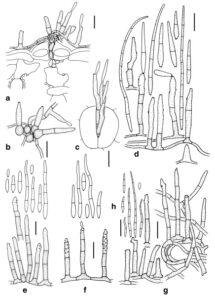Pteridopassalora lygodii (Sawada ex Goh & W.H. Hsieh) C. Nakash. & Crous, in Chen et al., Stud. Mycol. 101: 550 (2022)
Index Fungorum Number: IF 841767; Facesoffungi Number: FoF 15741
Basionym: Pseudocercospora lygodii Goh & W.H. Hsieh, Trans. Mycol. Soc. Rep. China 2 (2): 131. 1987.
Leaf spots indistinguishable from those associated with Periconiella lygodii. Hyphae internal, intercellular, pale brown, smooth, 1–3 μm wide, and external, penetrating through stomata, pale brown, smooth or rarely with some remote verruculose ornamentation, 1.5–2 μm wide. Stromata lacking or composed of a few cells and up to 10 μm diam., pale brown. External hyphae and conidiophores not seen with the dissecting microscope but only with the light microscope (in R. Kirschner 4182 seen on petioles with the dissecting microscope), considerably rarer in preparations from the adaxial side than from the abaxial one. Conidiophores arising in small fascicles up to 8 and as secondary ones from external hyphae, both kinds of conidiophores differing only by their basal cell (cylindrical to subglobose in fasciculate conidiophores, hyphal in secondary ones) and slightly by sizes, unbranched, straight or geniculate, pale brown, smooth, 0–5-septate, septa ca. 5–15 μm apart, fasciculate ones (13–)21–46(−62)×3–4(−5) μm (n=30), secondary ones 10–64×3–4 μm (in the type 15–94×3–4 μm). Conidiogenous cells terminal, rarely intercalary, straight or geniculate, paler than the conidiophore base, (8–)13–22(−27)×3–4(−5) μm (n=30), with up to 5 darkened and slightly thickened
conidiogenous loci widely dispersed along the cell, or (in the type and R. Kirschner 4182) occasionally with more than 5 conidiogenous loci covering the cell, 1–2 μm wide. Conidia solitary, narrowly cylindrical-obclavate, straight to undulate, very pale brown (but rather hyaline in the other specimens), smooth, 0–14-septate, 16–112(−193)×(2–)2.5–3(−4) μm (n= 30; occasionally shorter, 10 μm long; in the type 6–44×2–3.5 μm), hila thickened and darkened, 1–2 μm wide. Culture (derived from R. Kirschner 4182) on CMA slow-growing, greenish olivaceous, velvety, reverse dark brown. Hyphae pale brown, smooth, 2–3 μm wide. Conidiophores similar to those in situ, pale brown, but sometimes slightly darker than the hyphae, smooth, 0–4-septate, (11–)19–37(−46)×2–3 μm (n=30). Conidiogenous cells terminal, similar to those in situ or with somewhat more pronounced geniculations at the apex bearing darkened and slightly thickened, 1 μm wide conidiogenous loci. Conidia as in situ, but more conspicuously pale brown, 0–7-septate, (8–)21–64(−81)×2–3 μm (n=30), hila as in situ.
Typus: Taiwan Island, Hsinchu County, Hsinpu, on pinnules of Lygoium japonicum (Lygodiaceae), 2 May 1920, E. Kurosawa (holotype PPMH); Taipei City, Tianmu Trail, on pinnules of Lygoium japonicum, 4 Apr. 2015 (epitype designated here TNM R. Kirschner 4182, MBT 10003650, culture ex-epitype BCRC FU30503).
Known hosts and distribution – On Lygodium japonicum (Lygodiaceae/Schizaeaceae), mainland China (new record), Taiwan island (Hsieh and Goh 1990).
Notes – Based on morphological similarity to the holotype, an epitype collected on the same host from Taiwan island is proposed.

Figure 1 – Pteridopassalora lygodii. a–d Specimen from mainland China (R. Kirschner 4155-B); a part of transversal leaf section showing external hyphae and
conidiophores arising from stoma; b fascicle of conidiophores detached from the leaf; c fascicle of conidiophores arising from stoma; d conidiophores arising from
external hyphae, and conidia; e conidiophores and conidia from type; f–h conidiophores and conidia from recent Taiwanese collection (R. Kirschner 4182); f in situ; g–h in culture. Scale bars 10 μm, except (h) 20 μm.
